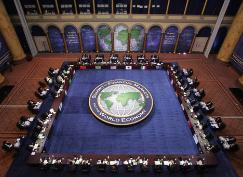South Korea is set to host the G-20 leaders' summit in Seoul on Thursday and Friday, the fifth such gathering since the onset of the global financial crisis. While past summits have focused on coordinated stimulus, global financial regulation and reform of the major international financial institutions, this week's meeting is gearing up to be known as the "trade and currency summit." It is also likely to be more tense and contentious than any of its predecessors, whether leaders admit it publicly or not. This is especially true when it comes to the ongoing economic prize-fight between the G-20's two juggernauts, the U.S. and China, which is likely to dominate Seoul, at least behind the scenes. Unlike previous summits, where China largely bit its tongue in the face of Washington's accusations, Beijing seems willing to go on the offensive this go-round.
At the heart of the conflict between the U.S. and China are the issues of slow growth rates, trade deficits and debt. As the memory of the financial crisis recedes, the U.S. and other industrialized economies are starting to focus on cutting their massive debts while jumpstarting economic growth. This combination of goals is not easy to achieve, as they are often in conflict with one another. For instance, countries can cut debt through domestic adjustment, such as reducing government spending, raising taxes and increasing interest rates, as some European countries like Greece and England are doing. But many argue that this course is counterproductive, as these moves tend to negatively affect overall economic growth.
However, domestic adjustment is not the only method for reducing debt: Countries can also pursue external policies that improve their trade positions, since it is much easier to reduce a debt load while running a trade surplus. For years, the U.S., as well the U.K., France and others, have been running large trade deficits. They are now looking to bring these deficits into balance, in order to export their way out of debt. But since trade restrictions, subsidies and tariffs are largely off the table due to trade agreements and international norms, they are turning to exchange rates as their primary policy weapon.

